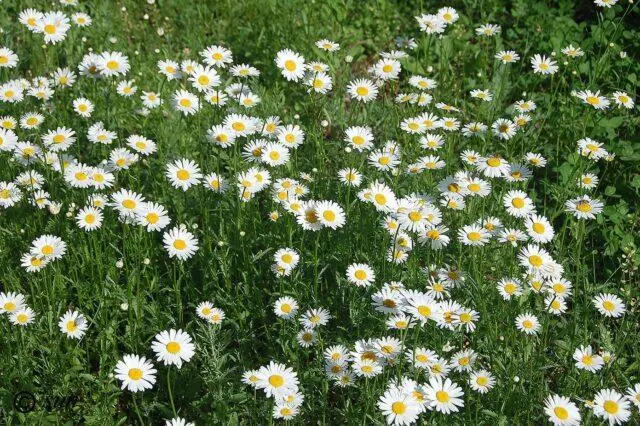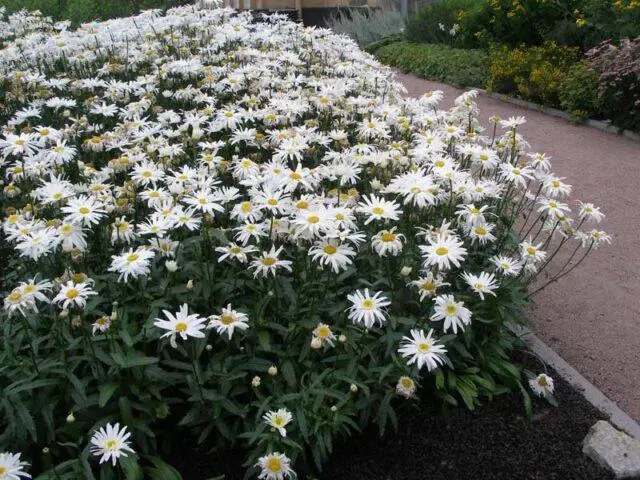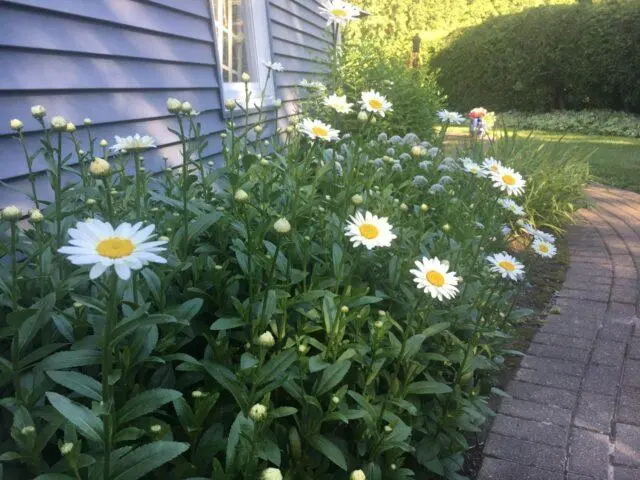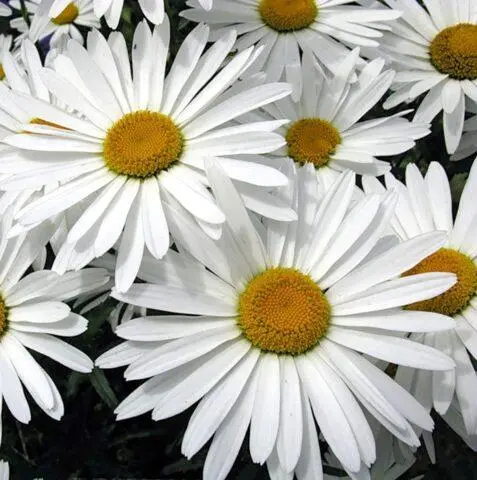Contents
- Description of the field
- Varieties of leucanthemum with photos and names
- Growing cornflower seedlings from seeds at home
- When to plant cornflower seedlings in open ground
- How to plant cornflower seeds in open ground
- Nivyanik care
- Nivyanik breeding
- Diseases and pests
- Photo nivyanik in landscape design
- Interesting facts about leucanthemum
- Conclusion
Common leucanthemum (Leucanthemum vulgare), or garden chamomile, is an elegant flower often found in flowerbeds in home gardens. Its cultivation is considered an easy process that does not require much time and effort. The plant is not whimsical at all, it goes well with other flowering crops, it is appropriate in different parts of the site.

Common leucanthemum has several varieties and many subspecies.
Description of the field
The culture belongs to the Compositae family, among the people it is often called garden chamomile, leukantemum or popovnik. The flower can be either a perennial or an annual, but according to the botanical description, it is a herbaceous rhizome perennial plant.
The common daisy is characterized by strong and tall (up to 100 cm) erect stems, at the end of which there are delicate, odorless inflorescences, up to 15 cm in diameter. They have two rows of white petals arranged around a yellow cockle. Flowering culture is long, can be observed from early to late summer. Some varieties bloom as early as May.
The stems of the plant are slightly pubescent, weakly branched, covered with smooth leafy plates of rich green color, which are held on short petioles. Their shape is oblong, oval, sometimes with a jagged border. Some species form a basal rosette of leaves. The main feature of the plates is that the higher they are located, the smaller their size.
After the end of the flowering period, the buds of the plant shed their petals and form a box with seeds in the central part. There are a lot of fruits, up to 25 thousand pieces.

For many years, the common leucanthemum was attributed to the genus of chrysanthemums.
Where does cornflower grow
Common leucanthemum is widely distributed in its natural habitat. It is often found in Europe, can grow in regions of North America, Australia, New Zealand, Asia. In Eurasia, it grows in forest clearings, meadows, fallows, and can become a weed in vegetable gardens and fields.
When the cornflower blooms
The flowering period of the crop depends on the variety. Most often, buds begin to form towards the end of June, but some species bloom in the spring. The end of the budding period also falls on different dates, but by the fall there are no more buds on the culture.
Winter hardiness of the sedge
Perennial subspecies of culture can endure winter under light cover. Before the onset of the first frost, they are simply covered with leaves or spruce branches. Some varieties do not need warming at all.
Varieties of leucanthemum with photos and names
Specialists did a good job of breeding different varieties of garden chamomile. As a result, they received about 50 of its varieties, among which there are specimens with large baskets, double and semi-double inflorescences. In ornamental gardening, several of them deserve great love:
- Silver Spoons is a new variety characterized as an upright plant, the marginal flowers of which, before dissolving, have the appearance of a cutlery. They look beautiful in the cut, suitable for flower beds, flower beds and group plantings.

The height of the common daisy Silver spoons can be up to 120 cm
- Maxima Kenig (Maxma Kenig) – tall variety with large flowers. The petals of the buds are white, long.

Maxima Koenig blooms from July to the end of August
- San-Sousi – a variety up to 1 m tall with basket inflorescences. Terry buds, large.

Sanssouci blooms all summer long
- May Queen – an ordinary daisy up to 0,5 m high. The flowers of the variety are snow-white, 10 cm in diameter.

May Queen blooms in late spring
Growing cornflower seedlings from seeds at home
Gardeners who are going to plant cornflower seedlings at home start work already at the end of winter. They operate according to the following scheme:
- Gravel is poured into the bottom of the prepared containers.
- Nutrient soil is laid on top of the drainage.
- Carry out watering.
- Planting material is evenly distributed on the surface of the earth.
- Sprinkle with soil.
- Cover with foil until sprouts appear.
As soon as the sprouts appear on the surface of the soil, the shelter is removed and the standard seedling care is carried out until it is planted in a flower bed.
When to plant cornflower seedlings in open ground
Ready-made seedlings are planted in open soil in the second half of May, when the threat of frost has passed. Undersized bushes are located at a distance of 30 cm, high ones at an interval of 70 cm, to a depth of one and a half times more than a clod of earth. After planting, the soil is compacted and watered.

It is advisable to mulch the soil around the bushes of the plant
How to plant cornflower seeds in open ground
It is possible to plant ordinary cornflower with seeds both for seedlings and immediately into the ground. In the middle lane, work begins at the end of April, when during the daytime the temperature is kept at +15 ° C, in the south, you can perform the procedure a couple of weeks earlier. Some gardeners practice planting cornflower in the fall, before winter. So the plants become stronger and more resilient, although the germination of seeds is slightly reduced. The algorithm for landing in open ground is as follows:
- A week before planting, the flower bed is dug up with compost.
- Before sowing, the plot is watered with warm water.
- Make grooves 20 mm deep, at a distance of 30 to 50 cm from each other.
- Perform sowing seeds.
- Sprinkle the bed with a mixture of peat and garden soil.
- Plantings are watered from a watering can, covered with a film until germination.
Nivyanik care
The flower is very easy to care for. If the landing site is chosen correctly, all agrotechnical procedures are carried out in a timely manner, the flowering of the crop will be long and plentiful. Elevations, soft and loose soil with neutral acidity are best suited for the plant. The place should be located on the sunny side, without shading.
Among the main procedures for caring for a crop, watering, fertilizing, preparing for winter are distinguished. Also, to stimulate the formation of new buds, it is desirable to form the bushes and free them from wilted flowers, and after flowering, the cornflower should be cut to a height of 10 cm above the soil.

The plant can bloom twice a season
Watering
Common daisy does not like moisture, and some of its species need additional drainage. Watering is carried out as needed, about once a week. After the procedure, the earth is loosened shallowly, weeds are removed.
How to feed a cornflower
The plant at any age responds well to fertilizers. It reacts best to organics in the form of chicken manure or manure, as well as to bone meal and nitrophoska. Substances are allowed to be applied up to three times a month.
Preparing a cornfield for winter
Common leucanthemum is prepared for frost when all the buds on the bushes have faded. So that the roots of the plant do not freeze, the soil is covered with leaf litter or covered with spruce branches.
Nivyanik breeding
Reproduction is carried out in different ways. The simplest and most common is the method of dividing the bush or cuttings. It is also possible to grow cornflower from seeds. In this case, seedlings can be planted both on seedlings and immediately in open ground.
Move the culture to a new place in the spring at the initial stage of active growth. They dig bushes together with an earthen clod, if necessary, they are divided. In the autumn, replanting the common daisy is also allowed. But you need to complete the work 3-4 weeks before the onset of frost.

In one place, the common daisy lives up to seven years.
Diseases and pests
Common daisy can be subject to some diseases. Especially with frequent and dense plantings, as well as during prolonged rains, it is vulnerable to powdery mildew, fusarium, rot, rust, ramularia. At the initial stage of any disease, you can try to overcome it with a tobacco solution.
Of the pests, aphids attack the common daisy. They get rid of it with the help of treatments with Actellik or Karate.
Photo nivyanik in landscape design
An ordinary leefflower in a flower bed (photos of flowers are presented below) can be in harmony with almost all ornamental plants. It is often planted along hedges, against the walls of unsightly buildings, in front gardens near house territories. Some species are used to decorate bouquet compositions.

Alpine variety suitable for planting in hills

With the help of Little Princesses, they decorate paths and edge flower beds.
Interesting facts about leucanthemum
Among the interesting facts about the plant are:
- It can be grown as an ornamental flower on any continent.
- All types of culture used to be classified as chrysanthemums.
- Common daisy is often confused with chamomile, although these are different flowers.
- The plant is the official flower emblem of Skåne (a small town in Sweden).
- How many types of culture are unknown.
- The buds of the plant do not emit fragrance.
Conclusion
Common leefflower is an undemanding pretty flower that will perfectly complement the landscape design of any flower bed. The plant is common in many countries, is divided into several types. There are also especially beautiful decorative varieties used for cutting and arranging bouquets.













